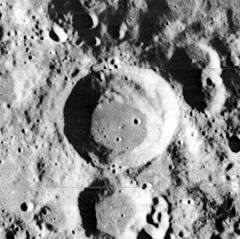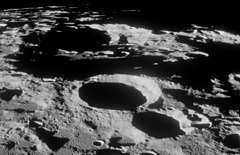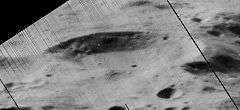Engel'gardt (crater)
Engel'gardt is a lunar impact crater on the far side of the Moon, located to the north of the huge walled plain Korolev. The satellite crater Engel'gardt B is attached to the north rim of this crater, and is actually a much larger formation with a diameter of 163 km. To the west-northwest is the crater Lebedinskiy.
 Lunar Orbiter 1 image | |
| Coordinates | 5.39°N 159.47°W |
|---|---|
| Diameter | 43 km |
| Depth | Approximately 8 km |
| Colongitude | 160° at sunrise |
| Eponym | Vasilij P. Engel'gardt |


This is a circular crater with a rim that has been only mildly eroded. The material on the inner sides has slid down to form piles of scree along the base. The inner wall is narrowed to the south, where the satellite crater Engel'gardt N lies adjacent to the edge. Less than a crater diameter to the east-southeast is a small crater with a high albedo surrounded by a skirt of light surface. This skirt reaches to the edge of Engel'gardt's rim.
The highest-elevation point on the entire surface of the Moon (10,786 m/35,387 ft above the mean lunar elevation) is located on the east rim of Engel'gardt Crater.[1]
Engel'gardt lies on the southern margin of the Dirichlet-Jackson Basin.
Satellite craters
By convention these features are identified on lunar maps by placing the letter on the side of the crater midpoint that is closest to Engel'gardt.
| Engel'gardt | Latitude | Longitude | Diameter |
|---|---|---|---|
| B | 8.3° N | 157.7° W | 136 km |
| C | 10.1° N | 156.9° W | 49 km |
| J | 2.7° N | 155.4° W | 19 km |
| K | 2.4° N | 157.8° W | 18 km |
| N | 4.4° N | 159.3° W | 28 km |
| R | 4.4° N | 162.0° W | 15 km |
References
- Motomaro Shirao, Charles A. Wood, 2011, The Kaguya Lunar Atlas: The Moon in High Resolution, Plate 85: High Point. Springer Publications
- Andersson, L. E.; Whitaker, E. A. (1982). NASA Catalogue of Lunar Nomenclature (PDF). NASA RP-1097. Archived from the original on 2014-10-06.CS1 maint: ref=harv (link) CS1 maint: BOT: original-url status unknown (link)
- Blue, Jennifer (July 25, 2007). "Gazetteer of Planetary Nomenclature". USGS. Retrieved 2015-01-24.CS1 maint: ref=harv (link)
- Bussey, B.; Spudis, P. (2004). The Clementine Atlas of the Moon. New York: Cambridge University Press. ISBN 978-0-521-81528-4.CS1 maint: ref=harv (link)
- Cocks, Elijah E.; Cocks, Josiah C. (1995). Who's Who on the Moon: A Biographical Dictionary of Lunar Nomenclature. Tudor Publishers. ISBN 978-0-936389-27-1.CS1 maint: ref=harv (link)
- McDowell, Jonathan (July 15, 2007). "Lunar Nomenclature". Jonathan's Space Report. Retrieved 2007-10-24.CS1 maint: ref=harv (link)
- Menzel, D. H.; Minnaert, M.; Levin, B.; Dollfus, A.; Bell, B. (1971). "Report on Lunar Nomenclature by the Working Group of Commission 17 of the IAU". Space Science Reviews. 12 (2): 136–186. Bibcode:1971SSRv...12..136M. doi:10.1007/BF00171763.CS1 maint: ref=harv (link)
- Moore, Patrick (2001). On the Moon. Sterling Publishing Co. ISBN 978-0-304-35469-6.CS1 maint: ref=harv (link)
- Price, Fred W. (1988). The Moon Observer's Handbook. Cambridge University Press. ISBN 978-0-521-33500-3.CS1 maint: ref=harv (link)
- Rükl, Antonín (1990). Atlas of the Moon. Kalmbach Books. ISBN 978-0-913135-17-4.CS1 maint: ref=harv (link)
- Webb, Rev. T. W. (1962). Celestial Objects for Common Telescopes (6th revised ed.). Dover. ISBN 978-0-486-20917-3.CS1 maint: ref=harv (link)
- Whitaker, Ewen A. (2003). Mapping and Naming the Moon. Cambridge University Press. ISBN 978-0-521-54414-6.CS1 maint: ref=harv (link)
- Wlasuk, Peter T. (2000). Observing the Moon. 1. Springer Science & Business Media. ISBN 978-1-852-33193-1.
